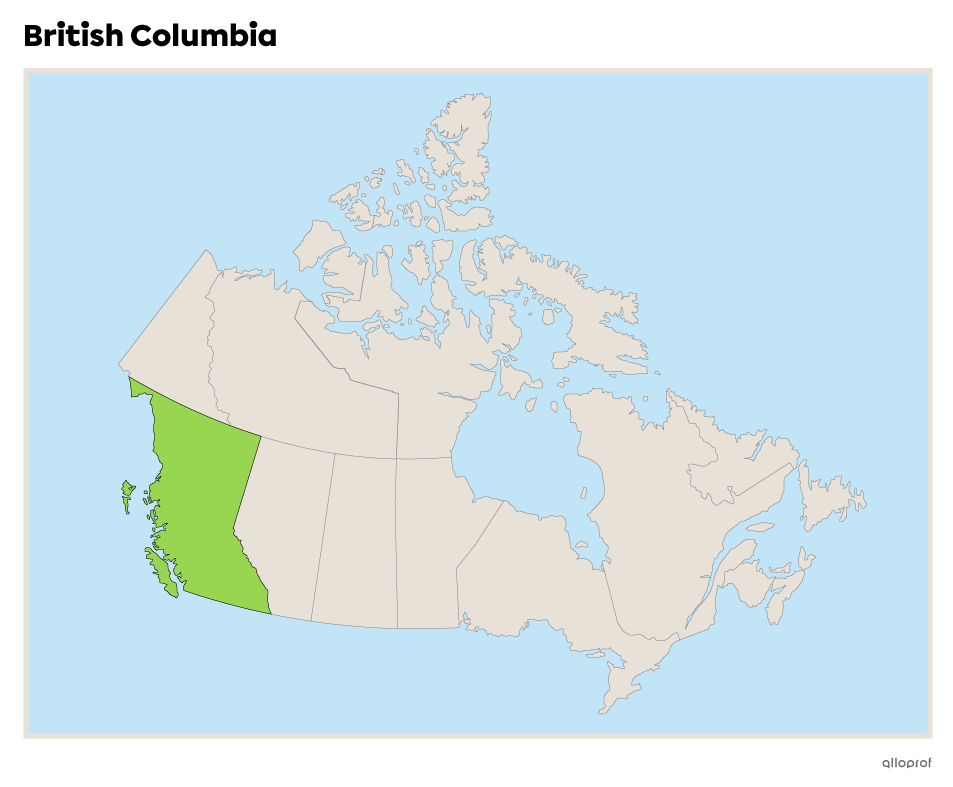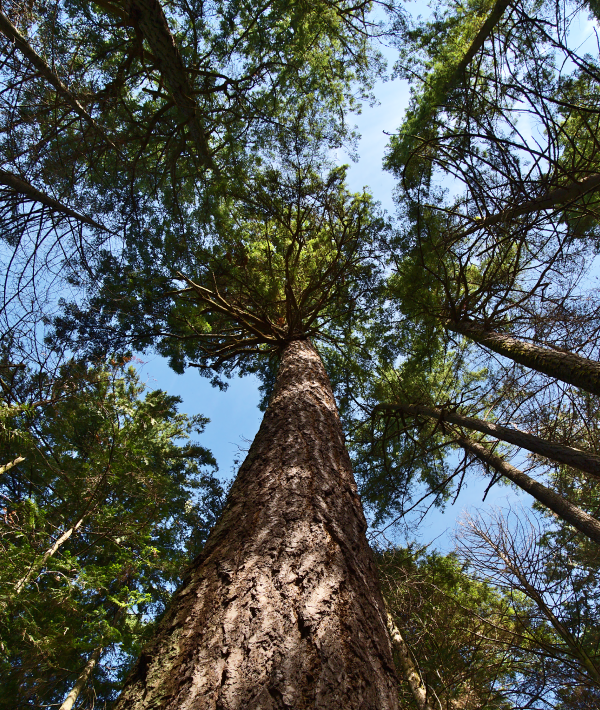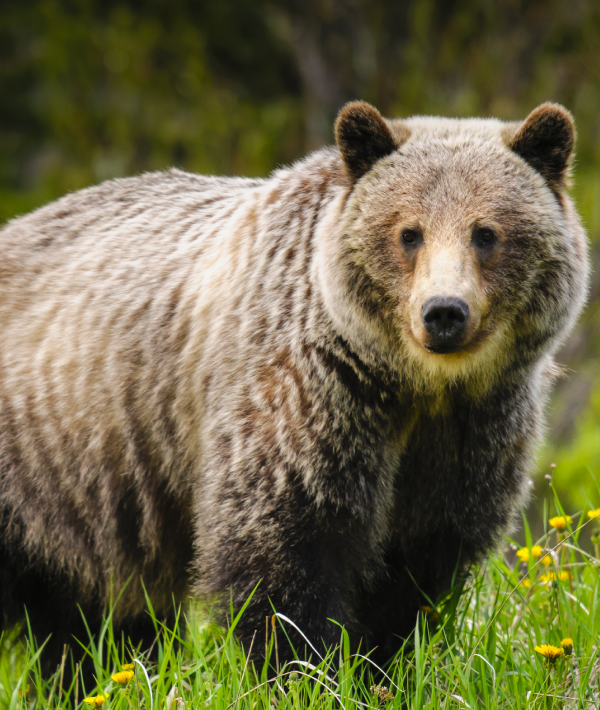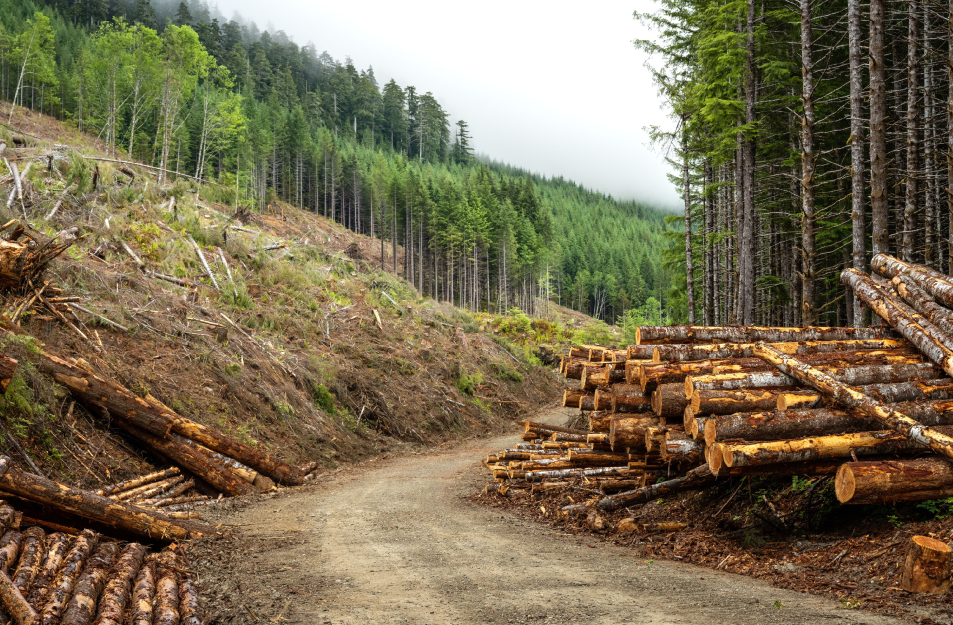British Columbia’s Forest Regions
To access the other sheets in the Forest Regions module, consult the See Also section.
British Columbia is Canada’s western-most province. Its west coast is bordered by the Pacific Ocean.

The Characteristics of British Columbia’s Forest Regions
There are two main climates in British Columbia: the oceanic temperate climate in the Pacific coast region and the mountain climate in the Rockies.
This Canadian province is mostly covered by two types of forest: the boreal forest to the north and the temperate forest in the rest of the territory. Unlike the other temperate forests of the world, however, British Columbia’s temperate forest consists of more softwoods than hardwoods.

A Douglas Fir
There are large numbers of this type species of tree in the territory of British Columbia. Some of these trees reach impressive heights of 60 m to 100 m[1].
Source: T. Schneider, Shutterstock.com
Ecological Role
British Columbia’s forest is home to some of the greatest biodiversity on the planet.
Its fauna includes:
-
the grizzly bear
-
the bald eagle
-
the red-legged frog
Its flora includes:
-
the western red cedar
-
the red huckleberry
-
various types of moss

A Grizzly Bear
This is one of the most impressive feared species in British Columbia.
Source: BGSmith, Shutterstock.com
Biodiversity refers to the diversity of species (animals, plants, fungi and protists) and ecosystems in a given territory.
Temperate rainforests are very important in the production of oxygen through the process of photosynthesis.
Economic Role
Exploitation of Forests
The exploitation of forests is a very important economic activity in British Columbia’s forest regions. Most of the wood is processed into lumber.
The province’s forests have been logged since the beginning of the 20th century. Logging companies employed clear-cutting practices until the 1990s when the government of British Columbia introduced regulations to ensure more sustainable logging practices:
-
Cutting zones were defined.
-
The quantity of wood that could be harvested was defined.
-
Reforestation became mandatory.
-
Selective cutting could be imposed.
Lumber refers to wood used for construction, such as planks and beams.

Forest Exploitation Zone in British Columbia
Source: Wirestock Creators, Shutterstock.com
Mining
Mining activities are also carried out in the province’s forest regions, digging for underground mineral ores. In 2020, the mining industry employed more than 11 000 workers[3].
Be careful!
Tourism and recreational activities in the forest regions also play an economic role because they contribute to the province’s economy and create jobs.
Stakeholders in British Columbia’s Forest Regions
Several groups co-exist in the province’s forest regions and each of these groups has a role to play. Here are the main stakeholders in British Columbia’s forest regions.
| Stakeholder | Role |
|---|---|
| The provincial and federal governments | They regulate the exploitation of the territory. |
| Indigenous peoples | They protect their land and their culture. |
| Logging companies | They harvest wood in the forests. |
| Wood processing companies | They process logs into lumber. |
| Mining companies | They mine the underground mineral ores in the province’s forests. |
| Environmental groups | They defend the territory and its natural resources as well as the province’s old-growth forests. Their goal is to ensure sustainable development in the territory. |
-
An old-growth forest is a forest that humans and natural phenomena have had little impact on, allowing the trees to grow very old.
-
A natural phenomenon is an event that occurs in nature, without any human intervention. This could be an earthquake, hurricane, aurora borealis, etc.
The Planning and Development of British Columbia’s Forest Regions
British Columbia’s forest regions have been planned and developed to respond to the needs of various stakeholders, including logging companies and outdoor enthusiasts. These interventions vary depending on the needs.
Planning and development for logging companies
-
Logging roads are built in order to access remote areas.
-
Logging camps are built to house workers.
Planning and development for outdoor enthusiasts
-
Trails are built for various activities such as walking and snowshoeing.
-
Lookouts are built to provide the population with scenic views of the territory.
-
Reception buildings are constructed for the various national parks.
Threats and Issues
Mountain Pine Beetle
The mountain pine beetle is a threat to the province’s forests because although it has always been present in the region, its presence was naturally regulated. In other words, its presence is normal and part of the ecosystem. However, certain factors, such as global warming, have increased their numbers and caused serious damage to pine forests.
Forest Fires
Forest fires are a natural phenomenon and essential to preserving the equilibrium of forest regions. For example, forest fires release nutrients located in the surface layer of forest soil. These fires also play a role in the reproduction of certain tree species by causing cones to open so that the seeds can disperse, allowing new trees to grow.
However, climate change is increasing the number of fires with serious consequences:
-
The forest landscape is changing because certain species of trees grow faster after a fire.
-
The forest industry could face difficulties because the forests are younger.
-
Populations living close to forests run the risk of losing their homes.
Relationships with Indigenous Peoples
Of the 202 Indigenous communities living in British Columbia, many of them, including the Squamish First Nation, demand the right to manage the forests in their ancestral territories[4]. The government of British Columbia is making greater efforts to include the Indigenous input in the province’s forest management with the intention of working hand in hand with Indigenous communities.
See Also
- Hinterland’s Who’s Who, The Coastal Rainforest
- Statistics Canada, An overview of forest resources
- CBC, How forests could help turn climate change around
- CBC, What you need to know about old growth trees in B.C. — and the threats facing them
- Radio-Canada, «La «forêt amazonienne» du nord à risque de disparaître»
Forest Regions
To access the rest of the module, you can check out the following concept sheets.
References
- Top of page
- The Characteristics of British Columbia’s Forest Regions
- Ecological Role
- Economic Role
- Social and Cultural Role
- Stakeholders in British Columbia’s Forest Regions
- The Planning and Development of British Columbia’s Forest Regions
- Threats and Issues
- Mountain Pine Beetle
- Forest Fires
- Relationships with Indigenous Peoples
- See Also
- Forest Regions

















































Social and Cultural Role
In British Columbia, people practise a variety of outdoor activities, including hunting, fishing, mountain biking and hiking. With its seven national parks and hundreds of provincial parks, the forest has been developed to allow the population to take advantage of these activities.